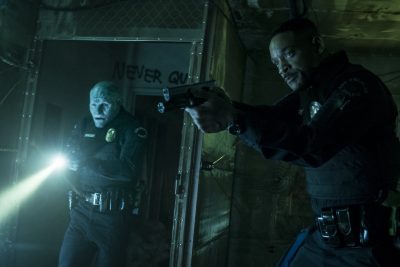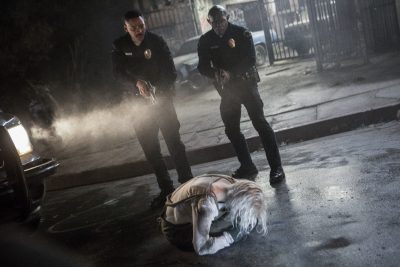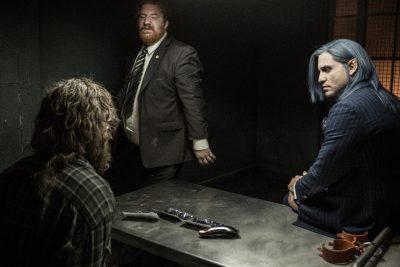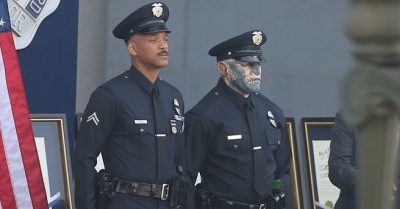
Bright – Officers Nick Jakoby (Joel Edgerton) and Daryl Ward (Will Smith) – Photo courtesy of Netflix.
David Ayer’s Bright is a fantasy buddy cop movie that leaves its audience with more questions than it answers.
Bright is set in a modern-day Los Angeles in a world where Orcs, Elves and Humans have lived side-by-side for millennia.
Right there we have a question – how is it that three such distinctive races (that’ve had their own cultures and beliefs) have wound up living in modern human cities (even allowing for the slightly exotic, gated community of Elftown)? It’s a question that is never answered.
In this version of Los Angeles, we open on Officer Daryl Ward (Will Smith) being shotgunned while his new, Orcish partner, Nick Jakoby (Joel Edgerton) is getting him a burrito.

Bright – Officer Daryl Ward (Will Smith), Tikka (Lucy Fry) and Officer Nick Jakoby (Joel Edgerton) – Photo courtesy of Netflix.
When he returns to work, his Sergeant (Margaret Cho) refuses to let him change partners – leading to an Internal Affairs investigation over Jakoby letting Ward’s shooter get away.
There’s also a faction of Ward’s precinct that wants to get rid of Jakoby by any means necessary – and when Ward and Jakoby answer a call that leads to a pitched battle and the apprehension of an Elf called Tikka (Lucy Fry), the presence of a magic wand leads to Ward having to choose between letting his partner be killed by four corrupt cops, or opposing them and be killed alongside him.
Then there are the feds who investigate suspected magic – who have come to town because of rumors of a wand in the city (where wands come from; how they come into play, and why would someone have one in L.A. are given only cursory explanation).

Bright – The Feds: Montehugh (Happy Anderson) and Sharps (Criag Henningsen) – Photo courtesy of Netflix.
In short, a magic wand is a nuclear bomb that grants wishes. The wand in question was taken from its owner – Leilah (Noomi Rapace), who amounts to the film’s Big Bad and is poorly served by the script – by Tikka. The call Ward and Jakoby answers leads to Tikka and the wand being in their custody.
Rumors about the wand lead to the trio becoming the target of Leilah and her followers (who want to use it to summon the Dark Lord who was banished form the world two thousand years ago), human gangs (one in particular wants the wand to restore the use of its wheelchair-bound leader’s lower body and Orcs (who always seem to be stereotyped as bad guys for picking the wrong side in that war two thousand years ago).
The wand, we learn, can only be wielded by Brights – usually Elves, but also the very occasional Human.

Bright – Leilah (Noomi Rapace) – Photo courtesy of Netflix.
Without the use of magic, Bright is a gritty urban buddy cop movie. Either way, it’s filled with clichés, banal chatter and way too many occasions on which one character tells another to shut up.
Bright looks great – the cinematography is first-rate; the CG effects are well done; the makeup is amazing (the Orcs are truly unique), and the action set pieces are well choreographed.
Weirdly, questions arise from the unlikeliest things – Orcs are derisively referred to as pigskins, which begs the question of what do they call footballs in the NFL? We know there’s an NFL because we’re told at one point that two-thirds of the linemen in the game are Orcs.

Bright – Officers Daryl Ward (Will Smith) and Nick Jakoby (Joel Edgerton) – Photo courtesy of Netflix.
The fact that such ponderings can even occur suggests that there’s something missing in the movie – probably a base from which the film can be supported. As it is, Bright floats in an unsupported world where stuff just seems to happen. Explanations when they come are quick and superficial, which doesn’t help.
On the other hand, everyone concerned is doing their part – besides the stuff mentioned above, the cast seemed fully committed to the film. It’s a shame that the script lets them down (Rapace, for example, is only allowed to be angry, implacable or sinister – or some combination of the three).
Ayer’s direction is fast-paced and hard-boiled – but it’s not fast enough to cover up the script’s limitations.
Judging from Bright’s final scenes, some though has been given to making it a franchise. It doesn’t deserve to be one.
Final Grade: D+